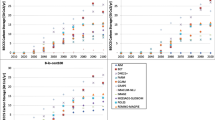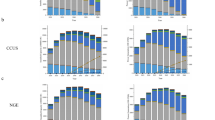Abstract
This paper explores the role of negative emissions technologies (NETs) in energy systems, bioenergy with carbon capture and storage (BECCS) and direct air capture (DAC) with geological carbon storage (DACCS) in particular, using a bottom-up energy system model TIMES-Japan that participated in the 35th study of the Stanford Energy Modeling Forum (EMF 35 JMIP) focusing on the energy transitions for the long-run climate goals. Modeling results show that large-scale deployment of NETs is essential to achieve the net-zero vision of Japan’s long-term strategy, however, these NETs might not be enough in the case of the highest energy service demands. Within the feasible solution space, earlier deployment of BECCS with domestic biomass can contribute effectively to achieve the target with the support of the DACCS at the later period if both technologies are available. It shows feasible results without DACCS only in the lowest energy service demands, implying the importance of urgent research, development, and deployment of DACCS. Furthermore, this study shows that earlier deployment of DAC system with CO2 utilization in fuel production is a cost-effective way to lead the large-scale deployment of the DAC as NETs.









Similar content being viewed by others
References
Akimoto K, Sano F (2017) Analyses on Japan's GHG emission reduction target for 2050 in light of the 2°C target stipulated in the Paris Agreement. Journal of Japan Society of Energy and Resources 38: 1–9 http://www.jser.gr.jp/journal/journal_pdf/2017/journal201701_1.pdf (in Japanese) [accessed April 29, 2020].
Daggash HA, Patzschke CF, Heuberger CF, Zhu L, Hellgardt KH, Fennell PS, Bhave AN, Mac Dowell N (2018) Closing the carbon cycle to maximise climate change mitigation: power-to-methanol vs. power-to-direct air capture. Sustain Energy Fuels 2:1153. https://doi.org/10.1039/c8se00061a
Davis SJ, Lewis NS, Shaner M, Aggarwal S, Arent D, Azevdo IL et al (2018) Net-zero emissions energy systems. Science 360:eaas9793. https://doi.org/10.1126/science.aas9793
de Jong MMJ, Daemen J, Loriaux JM, Steinmann ZJN (2019) Life cycle carbon efficiency of direct air capture systems with strong hydroxide sorbents. Int J Greenhouse Gas Control 80:25–31. https://doi.org/10.1016/j.ijggc.2018.11.011
Duscha V, Denishchenkova A, Wachsmuth J (2018) Achievability of the Paris Agreement targets in the EU: demand-side reduction potentials in a carbon budget perspective. Climate Policy 19:161–174. https://doi.org/10.1080/14693062.2018.1471385
Fasihi M, Efimova O, Breyer C (2019) Techno-economic assessment of CO2 direct air capture plants. J Clean Prod 224:957–980. https://doi.org/10.1016/j.jclepro.2019.03.086
Fuss S, Canadell JG, Peters GP, Tavoni M, Andrew RM, Ciais P, Jackson RB, Jones CD, Kraxner F, Nakicenovic N, Le Quéré C, Raupach MR, Sharifi A, Smith P, Yamagata Y (2014) Betting on negative emissions. Nature Climate Change 4:850–853. https://doi.org/10.1038/nclimate2392
HPTCJ (2017) Report on the perspectives on diffusion of heat pumps. (in Japanese) https://www.hptcj.or.jp/Portals/0/data0/press_topics/documents/%E2%98%85%E3%80%90%E6%B7%BB%E4%BB%98%E8%B3%87%E6%96%991%E3%80%91HP%E5%B0%86%E6%9D%A5%E5%83%8F%E3%83%BB%E6%99%AE%E5%8F%8A%E8%A6%8B%E9%80%9A%E3%81%97%E8%AA%BF%E6%9F%BB.pdf [accessed April 29 2020]
IEA (2017) World Energy Outlook 2017. OECD/IEA, Paris
IPCC (2018) Summary for Policymakers. In: Global Warming of 1.5 °C. An IPCC Special Report on the impacts of global warming of 1.5 °C above pre-industrial levels and related global greenhouse gas emission pathways, in the context of strengthening the global response to the threat of climate change, sustainable development, and efforts to eradicate poverty [Masson-Delmotte V, Zhai P, Pörtner H.-O, Roberts D, Skea J, Shukla PR, Pirani A, Moufouma-Okia W, Péan C, Pidcock R, Connors S, Matthews JBR, Chen Y, Zhou X, Gomis MI, Lonnoy E, Maycock T, Tignor M, Waterfield T (eds.)]
IPSS (2017) Population projections for Japan: 2016 to 2065. National Institute of Population and Social Security Research. http://www.ipss.go.jp/pp-zenkoku/e/zenkoku_e2017/pp_zenkoku2017e.asp. Accessed 29 Apr 2020
Ju Y, Sugiyama M, Kato E, Matsuo Y, Oshiro K, Herran DS (2021) Industrial decarbonization under Japan’s national mitigation scenarios: a multi-model analysis. Sustain Sci. https://doi.org/10.1007/s11625-021-00905-2
Kato E, Kurosawa A (2019) Evaluation of Japanese energy system toward 2050 with TIMES-Japan – deep decarbonization pathways. Energy Procedia 158:4141–4146. https://doi.org/10.1016/j.egypro.2019.01.818
Kato E, Yamagata Y (2014) BECCS capability of dedicated energy crops under a future land-use scenario targeting net negative carbon emissions. Earth’s Future 2:421–439. https://doi.org/10.1002/2014EF000249
Keith DW, Holmes G, Angelo DS, Heidel K (2018) A process for capturing CO2 from the atmosphere. Joule 2:1573–1594. https://doi.org/10.1016/j.joule.2018.05.006
Kinoshita T, Ohki T, Yamagata Y (2010) Woody biomass supply potential for thermal power plants in Japan. Appl Energy 87:2923–2927. https://doi.org/10.1016/j.apenergy.2009.08.025
Kurosawa A, Hagiwara N (2012) Long term energy system analysis of Japan after March 11. 3rd IAEE Asian Conference, February 21, 2012. https://eneken.ieej.or.jp/3rd_IAEE_Asia/pdf/paper/106p.pdf [accessed April 29 2020].
Kurosawa A, Kato E (2018) Japanese energy system towards 2050 under low carbon scenario - an analysis using TIMES-Japan. Grand Renew Energy Proc. https://doi.org/10.24752/gre.1.0_6
Loulou R, Remne U, Kanudia A, Lehtila A, Goldstein G (2005) Documentation for the TIMES model - part I. http://iea-etsap.org/docs/TIMESDoc-Intro.pdf [accessed April 29 2020].
MAFF (2006) Strategy of biomass in Japan, 2006. (in Japanese)
Matsukawa H, Ohigashi T, Yamaya H, Ogimoto K (2017) Study on photovoltaic system installed capacity in Japan. Proceeding of 36th Annual meeting of Japan Society of Energy and Resources: 161–164 (in Japanese)
METI (2017) Basic Hydrogen Strategy. Ministerial Council on Renewable Energy, Hydrogen and Related Issues. https://www.meti.go.jp/english/press/2017/pdf/1226_003b.pdf [accessed April 29 2020]
METI (2018) Strategic Energy Plan. https://www.enecho.meti.go.jp/en/category/others/basic_plan/5th/pdf/strategic_energy_plan.pdf [accessed September 14 2020].
Nakanishi S, Mizuno Y, Okumura T, Miida H, Shidahara T, Hiramatsu S (2009) Methodology of CO2 aquifer storage capacity assessment in Japan and overview of the project. Energy Procedia 1:2639–2646. https://doi.org/10.1016/j.egypro.2009.02.031
Otto A, Robinius M, Grube T, Schiebahn S, Praktiknjo A, Stolten D (2017) Power-to-steel: reducing CO2 through the integration of renewable energy and hydrogen into the German steel industry. Energies 10:451. https://doi.org/10.3390/en10040451
Realmonte G, Droouet L, Gambhir A, Glynn J, Hawkes A, Köberle AC, Tavoni M (2019) An inter-model assessment of the role of direct air capture in deep mitigation pathways. Nat Commun 10:3277. https://doi.org/10.1038/s41467-019-10842-5
Saito T, Urabe CT, Ogimoto K (2017) Estimation of Japanese cumulative wind power capacity in 2050 (part2). Proceeding of 36th Annual meeting of Japan Society of Energy and Resources: 165–168 (in Japanese)
Sato O (2005) A study on long-term energy scenarios for Japan. JAERI-Research 2005–012. http://doi.org/https://doi.org/10.11484/jaeri-research-2005-012 (in Japanese) [accessed April 29 2020]
Shiraki H, Sugiyama M, Matsuo Y, Komiyama R, Fujimori S, Kato E, Oshiro K, Silva DH (2021) The role of renewables in the Japanese power sector: implications from the EMF35 JMIP. Sustain Sci. https://doi.org/10.1007/s11625-021-00917-y
Sugiyama M, Fujimori S, Wada K, Oshiro K, Kato E, Komiyama R et al (2021) EMF 35 JMIP study for Japan’s long-term climate and energy policy: scenario designs and key findings. Sustain Sci. https://doi.org/10.1007/s11625-021-00913-2
Sugiyama M, Fujimori S, Wada K, Endo S, Fujii Y, Komiyama R et al (2019) Japan’s long-term climate mitigation policy: multi-model assessment and sectoral challenges. Energy 167:1120–1131. https://doi.org/10.1016/j.energy.2018.10.091
Vogl V, Åhman M, Nilsson LJ (2018) Assessment of hydrogen direct reduction for fossil-free steelmaking. J Clean Prod 203:736–745. https://doi.org/10.1016/j.jclepro.2018.08.279
Acknowledgements
The authors are grateful for the support provided by the Environment Research and Technology Development Fund (JPMEERF20172004) of the Environmental Restoration and Conservation Agency of Japan.
Author information
Authors and Affiliations
Corresponding author
Additional information
Publisher's Note
Springer Nature remains neutral with regard to jurisdictional claims in published maps and institutional affiliations.
Handled by Masa Sugiyama, University of Tokyo, Japan.
Supplementary Information
Below is the link to the electronic supplementary material.
Rights and permissions
About this article
Cite this article
Kato, E., Kurosawa, A. Role of negative emissions technologies (NETs) and innovative technologies in transition of Japan’s energy systems toward net-zero CO2 emissions. Sustain Sci 16, 463–475 (2021). https://doi.org/10.1007/s11625-021-00908-z
Received:
Accepted:
Published:
Issue Date:
DOI: https://doi.org/10.1007/s11625-021-00908-z




